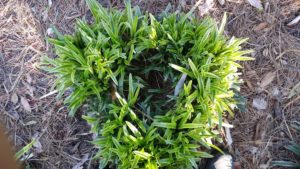Dividing Ornamental Grasses
go.ncsu.edu/readext?685539
en Español / em Português
El inglés es el idioma de control de esta página. En la medida en que haya algún conflicto entre la traducción al inglés y la traducción, el inglés prevalece.
Al hacer clic en el enlace de traducción se activa un servicio de traducción gratuito para convertir la página al español. Al igual que con cualquier traducción por Internet, la conversión no es sensible al contexto y puede que no traduzca el texto en su significado original. NC State Extension no garantiza la exactitud del texto traducido. Por favor, tenga en cuenta que algunas aplicaciones y/o servicios pueden no funcionar como se espera cuando se traducen.
Português
Inglês é o idioma de controle desta página. Na medida que haja algum conflito entre o texto original em Inglês e a tradução, o Inglês prevalece.
Ao clicar no link de tradução, um serviço gratuito de tradução será ativado para converter a página para o Português. Como em qualquer tradução pela internet, a conversão não é sensivel ao contexto e pode não ocorrer a tradução para o significado orginal. O serviço de Extensão da Carolina do Norte (NC State Extension) não garante a exatidão do texto traduzido. Por favor, observe que algumas funções ou serviços podem não funcionar como esperado após a tradução.
English
English is the controlling language of this page. To the extent there is any conflict between the English text and the translation, English controls.
Clicking on the translation link activates a free translation service to convert the page to Spanish. As with any Internet translation, the conversion is not context-sensitive and may not translate the text to its original meaning. NC State Extension does not guarantee the accuracy of the translated text. Please note that some applications and/or services may not function as expected when translated.
Collapse ▲Dividing your ornamental grasses helps to keep them healthy, strong, and vibrant! It is also a great way to add additional plants to your landscape without spending a dime.
Ornamental grasses come in a variety of shapes and sizes. They can provide color, vibrant texture, and year-round interest to a landscape. They are attractive when planted in large numbers or when they are used as a specimen or feature plant.
Ornamental grasses and a number of perennials have a unique growing style. The plant grows out from the center and new growth only occurs on the outer edges. It slowly dies out from the center leaving the plant wild and unsightly once it matures.

In order to avoid this wild and unsightly look, we must dig up, divide, and replant grasses every few years. One benefit of this practice is the creation of several new plants that you can add to your landscape or share with your friends!
Proper timing and preparation will greatly increase your chances of success. For best results, ornamental grasses should be dug and divided on a cloudy cool day in late winter or early spring. This will give the grass adequate time to establish before the hot summer months.
Preparing a new home for the additional plants that you are about to create in advance will help ensure success when transplanting grasses. Water your plants well for several days before division. In order to make transplanting easier, cut back the stems so that only 2 to 3 inches are left above the soil line. For most situations, pruning shears will work; however, larger grasses may require hedge trimmers or even a chainsaw.
After watering for a few days prior to transplanting it is time to dig and divide your grass. Begin digging a complete circle around the grass with a sharp-pointed shovel. Once you work completely around the grass, pry it out of the ground. The whole clump should be removed. Older more established grasses may have to be removed in sections.
Now that the clump is out of the ground and exposed, it is time to divide the grass using a sharp spade or ax. Divide sections that are at least 3” in diameter, from the outside edge of the clump. Divisions that are 3” in diameter will yield good first-year results. Avoid taking divisions from the center of the clump. Discard or cut up and compost the “dead” center portion of the clump.
Perhaps the easiest part of the transplanting process is planting the divisions. Dig a hole twice the size of the division root ball. Place the division in the hole so that crown is slightly below the soil line. Mix the soil removed from the hole with your favorite compost or garden soil, then fill the hole, water, and fertilize with a balanced fertilizer. A balanced fertilizer is a fertilizer that has three numbers which are the same, such as 10-10-10. If all goes well new growth will begin to emerge from the crown when the temperatures start to rise in the spring. For a short step-by-step, watch the how-to video below.
For additional information about dividing ornamental grasses or any other horticulture-related topics please contact Chris Blaha at 252-232-2262 or email ctblaha@ncsu.edu.




